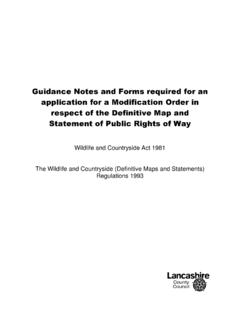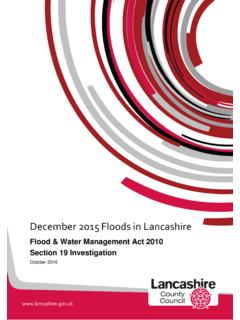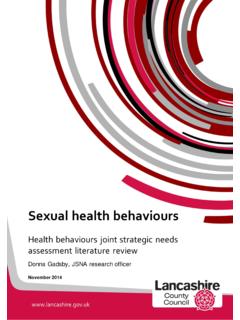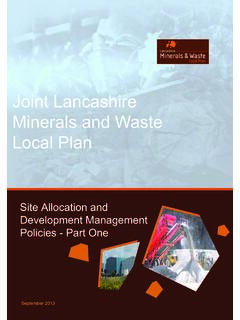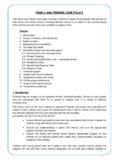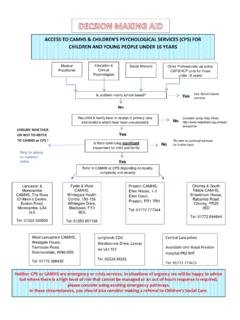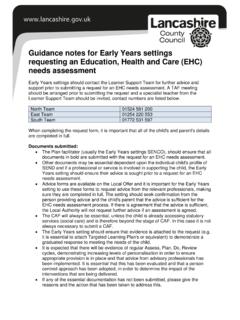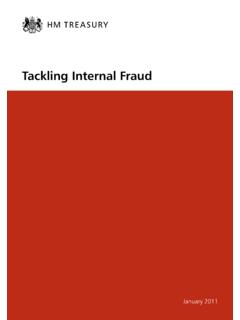Transcription of Lancashire and Blackpool Local Flood Risk …
1 1 Lancashire and Blackpool Local Flood Risk management StrategyOctober 2013 Draft for Consultation2 Lancashire Local Flood Risk management StrategyDraft for Internal CommentVersion D01 Flood Risk management TeamsLancashire County CouncilPO Box 78 County Hall Fishergate Preston Lancashire PR1 8 XJBlackpool Council Town Hall Blackpool FY1 1AD3 Executive SummaryThis Lancashire and Blackpool Flood management strategy has been jointly produced by Lancashire County Council and Blackpool Council to show how we intend to manage the risk from Local sources of flooding initially over the next 3 years and with revised editions every 6 years. Local sources of flooding are those from ordinary watercourses (small streams and channels), pluvial (surface water runoff as a result of heavy rainfall) and groundwater (where water held beneath the ground reaches the surface).
2 Water does not follow administrative boundaries. During a Flood event water flows where it wants to and natural catchments can channel water from one council s area to another. Blackpool Council and Lancashire County Council share a border with each other and there are several catchments that flow from Blackpool s administrative area into Lancashire and vice is also important to note that this does not just apply to the Lancashire and Blackpool administrative areas. Lancashire and Blackpool can be affected by water from catchments outside of both of our administrative boundaries and water from our catchments areas can affect other areas. It is therefore important that information is shared beyond administrative also have a good relationship in terms of the wider Flood Risk management roles we have as Lead Local Flood Authorities.
3 Our close proximity to each other means that in many instances we work together to manage developments, wider strategic infrastructure and issues such as flooding and water to the cross border nature of flooding and the on-going relationship we have, there are many benefits in working closely with each other to manage Local Flood risks and a decision was made to produce a joint document, the Lancashire and Blackpool Local Flood Risk management strategy (the Local strategy ). This strategy ensures a catchment based approach and promotes effective partnership working as advised by the principles laid out in the Environment Agency s National Local strategy is an important policy document because it is the first one that we have produced following the introduction of the Flood and Water management Act (2010).
4 The Act places a number of legal duties and responsibilities on county and unitary authorities, which are now defined as Lead Local Flood some of these duties and responsibilities are existing, many of them are new and require us to develop new approaches, systems and policies. This document explains how we intend to develop these. However, we realise that in order to successfully manage Local Flood risks we will need to work closely with other organisations responsible for managing Flood risk from other sources of flooding such as the Environment Agency (main rivers and the sea) and Water Companies (sewers).4We will also have to work with Local Planning Authorities within Lancashire to ensure that new development is safe from the effects of flooding and does not increase the risk of flooding.
5 Finally, we will have to work closely with the community as a whole as we will not be able to prevent all future flooding. No matter how much planning and work we do, there will still be a risk of flooding and communities will need to be involved in what we do and guide our this Local strategy we explain the nature of Local Flood risk across Lancashire , who is responsible for managing the various types of flooding and how we intend to meet our obligations. Throughout the document we present a number of strategic objectives that explain what we are aiming to achieve. In support of these we also include specific measures which show how we intend to achieve our objectives. Finally, these are presented as an Action Plan which states how and when we will deliver and implement these measures.
6 As this is a draft document, you are in a position to influence our Action Plan and we hope you will take this opportunity to influence Flood risk management activities in your Summary 31 Introduction Background 8 The Flood and Water management Act 8 The Local Flood Risk management strategy 9 A Joint Local
7 strategy 10 Other Sources of Flooding 10 Our Vision for Local Flood Risk management 11 Objectives and Measures of the strategy 11 Structure of this Document 122 Roles and Responsibilities for Managing Flood Risk 14 The Lead Local Flood Authority 14 Existing Duties and Responsibilities 14 New Duties and Responsibilities 15 The Environment Agency 15
8 Water companies 16 The Highways Authorities 16 Earby and Salterforth Internal Drainage Board 17 The District Councils 17 Coastal Protection Authorities 17 Other Organisations that Have a Role 18 Partnership Working 18 Our Strategic Objectives for Roles and Responsibilities 203 Local Flood Risk within Lancashire 22 Introduction 22 Existing Local Flood risks
9 24 Local Flood Risk in the West of Lancashire 24 Local Flood Risk in the East of Lancashire 24 Flood Risk by Local Authority 25 Future Risk from Local Sources of Flooding 29 Climate Change 29 Urban Growth and Development 30 Our Strategic Objectives for Managing Climate Change 3064 Our Local Flood Risk management Plan 32 Introduction 32 Prioritising Our Actions 34 Strategic Level Investigations & SWMPs 34 Flood Risk
10 management Studies by Others 35 Environment Agency Studies 35 Water Companies 35 Coastal Local Authorities & the Environment Agency 35 Interactions 35 Flood Investigations 35 Strategic Flood Risk management Planning Objectives and Measures 365 Emergency Planning 38 Introduction 38 Who Does What?


